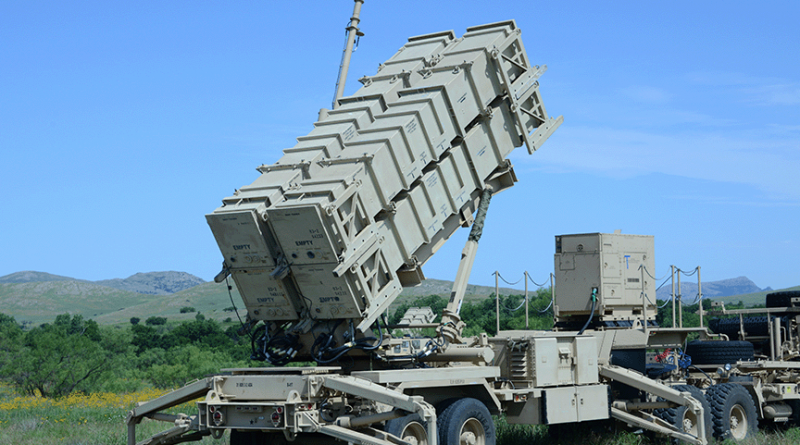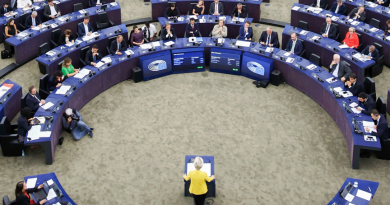Debt financing European air defence
Armin Steinbach is a Non-Resident Fellow and Guntram Wolff is a Senior Fellow, at Bruegel
Introduction
Ukraine is not the only part of Europe vulnerable to missiles and air attacks1. Current defensive capabilities, in particular NATO’s integrated air and missile defence systems2, do not provide full coverage of European critical infrastructure, let alone the full territory. However, experience in Ukraine and Israel shows that effective missile defence is feasible3.
It is also expensive. The cost of air-defence systems such as the US-made Patriot or the German IRIS-T are one reason why European governments have invested insufficiently. A single Patriot missile battery costs around $1 billion and a European build-up of air defence could easily amount to an investment in the hundreds of billions.
Sidestepping the fiscal rules that govern European Union countries by exceptionally issuing EU debt would provide resources for this costly air-defence roll-out, which is necessary to respond to mounting external security threats.
This act of mutual assistance would free national budgetary resources and provide long-term funding stability, while also boosting the domestic defence industry4. We discuss how such EU debt could be justified in EU law and implemented.
Sovereignty concerns
Defence has typically been considered an area of national sovereignty with little willingness to advance integration at EU level because of different national preferences. Defence and military capabilities are considered core sovereignty issues and reflect the ability of countries to effectively exercise state power (Dobbs, 2014).
Some national constitutional courts have identified defence as a core function for the sovereignty of the nation state, and core defence capabilities would therefore have to remain under national control, making any significant transfer of competence possibly unconstitutional (GFCC, 2009).
Accordingly, the EU Treaties flag defence and military issues as areas of national competence, with EU-based defence activities is limited in scope and constrained by unanimity voting.
Yet, European defence integration enjoys consistently high levels of public support (Mérand and Angers, 2014). Strategic threat perceptions can influence public opinion on European defence cooperation and integration – in particular the perception that Russia’s military activities in Ukraine threaten security – and increase support for the creation of a common European army (Graf, 2020).
Crises relax the ‘constraining dissensus’ in relation to defence integration (Burgoon et al 2023), and there is both cross-border support for European defence and converging preferences on the actual design of such a policy. Unsurprisingly perhaps, a somewhat ad-hoc German proposal on air defence, the European Sky Shield Initiative (ESSI)5, proposed by Chancellor Scholz in August 2022, was rapidly endorsed by 21 participating states, with Poland also considering participation.
ESSI is an initiative to strengthen the European pillar of NATO and build up capabilities in air defence. It involves air defence procurement, maintenance and use under NATO command.
However, France – not part of ESSI – has criticised the initiative, in part because of its focus on US and Israeli defence companies. The criticisms relate to strategic differences over deterrence doctrines and political, economic and industrial policy questions (Arnold and Arnold, 2023).
Since the inception of ESSI, some convergence has been achieved on these issues and French president Emmanuel Macron has recognised explicitly the importance of ESSI for countries without nuclear deterrence6. To make EU-level debt funding for air defence acceptable, it will be important to strengthen interoperability of systems and include at least to some degree the French-Italian SAMP-T system alongside IRIS-T and other European systems.
But if new EU debt was created to pay for air defence, purchases from US companies, as being done under ESSI, would not crowd out European industrial development.
Moreover, while the EU debt financing would be strictly limited in scope and volume to European air defence (mainly for legal reasons, outlined below), the financial investments would also provide long-term funding that would give the necessary stability to industrial policy and fiscal forward guidance for the industry to enhance production capacities.
Building-up the air defence capacities of domestic defence companies will provide a diversity of systems, making European air defence more resilient to possible disruptions from foreign suppliers.
Since air defence is an issue for Europe as a whole, any EU funding initiative should be open to European allies, including the United Kingdom and Norway, which are part of the same airspace that needs to be defended (and which are already part of ESSI). While the EU borrowing mechanism we propose would focus on EU procurement, non-EU allies could participate in some form.
Air defence as a European public good and its proper governance design
Why air defence is a European public good
While state-level defence has long been considered a public good, to what extent is defence a European public good? In the EU and NATO, all national armies provide to some degree a public good beyond the own security of their own nations, as they can be called on to provide collective defence.
As countries can, at least to some extent, count on assistance from others, there is an incentive to free ride on others’ provisioning of military services.
Air defence is particularly subject to strong scale effects and externalities. When it comes to threat detection, the more that radar and other detection systems are interconnected and the more data is shared, the easier it is to detect threats early on, reducing investment needs for each country.
For aircraft, cruise missiles and drones flying at low to medium altitude, countries of first entry should typically act to neutralise the threat, thereby providing a public good to more distant countries that might have been targeted. Even for high altitude ballistic missiles, detection and neutralisation can be done from countries other than that targeted.
For example, a ballistic missile threatening the Netherlands will unlikely be intercepted only over the Netherlands. European air defence is therefore a particularly robust public good that few European countries could provide alone.
There is thus a strong rationale for providing the public good at European rather than national level. With the fixed costs for building up air defence being significant, unifying national efforts can untap substantial savings.
To make EU-level debt funding for air defence acceptable, it will be important to strengthen interoperability of systems and include at least to some degree the French-Italian SAMP-T system alongside IRIS-T and other European systems
An adequate governance design for the air defence European public good
Characterising air defence as a European public good does not necessarily imply that all its elements should be centralised at EU level (Claeys and Steinbach, 2024). EU countries already apply so-called Permanent Structured Cooperation (PESCO) in defence cooperation in relation to research, procurement and armaments cooperation7.
Projects involving non-EU countries have also been pursued under the PESCO umbrella. PESCO could thus become the framework for some air defence equipment purchases and for enhancing R&D in air defence in collaboration, where applicable, with the European Defence Agency and the European Defence Fund.
It is not foreseen that the EU would play an operational role in air defence command, which would remain solely the competence of member states within the NATO framework. Some elements however could be delivered at EU level, including procurement of air defence systems (eg. joint large-scale purchases of military equipment).
In case of a less-ambitious approach, procurement could remain national but under a joint framework contract. Joint debt issuance would not require the European Commission to decide on spending, as this would remain the responsibility of member states, or if centrally decided, subject to unanimity in the Council of the EU.
Notwithstanding its benefits, joint procurement may result in some incumbent industrial players losing national market share. It is important to consider the political implications. Some compensation mechanisms are politically advisable to strengthen domestic defence industrial bases as they would not benefit directly from EU-funded ESSI procurement.
However, EU debt would increase the overall market size substantially and rapidly. Joint debt issuance and joint procurement would thus also increase budgetary resources for domestic defence systems, including SAMP-T and other PESCO development projects.
Debt-financing ESSI
Economic rationale for EU debt funding
PESCO projects are generally financed by the countries that participate in them8. In terms of air defence, joint debt issuance could increase the resources to fund procurement.
While procurement and funding would ideally be centralised to achieve efficiency gains, it is likely and possible that funds raised with EU debt would be first disbursed to EU countries, which would then spend them on ESSI projects in the context of PESCO.
The economic rationale for debt funding air defence is straightforward: building air defence systems represents a huge upfront investment. Once the system is in place, operational costs are relatively small. Large upfront investments should be funded by deficits for tax-smoothing reasons, and to spread costs over the periods during which systems will be operational.
Legal implications of EU debt financing air defence
The legal implementation of exceptional debt financing for ESSI is challenging but feasible. There is a general restriction preventing the EU budget funding expenditure related to operations with military or defence implications9.
However, our solution introduces EU borrowing ‘off-budget’ and outside the regular EU budget (similar to the EU post-pandemic economic recovery initiative, NextGenerationEU). Further guarantees to protect the financial interests of neutral states are possible.
A distinction must be made between borrowing for ESSI purposes and spending on ESSI activities. The European Commission is enabled to borrow on the EU’s behalf by the own resources decision (ORD) (Grund and Steinbach, 2023). This implies that borrowing for air defence requires a new ORD and hence requires ratification by EU countries in line with domestic constitutions10.
Spending of the funds raised needs to have a distinct legal anchor. In the case of NextGenerationEU (NGEU), this was the emergency clause in the EU Treaties (Article 122 TFEU), which permits the financing of targeted and temporary economic measures in exceptional situations. Despite obvious differences with NGEU, the building up of an ESSI-based air defence system can be likened to an emergency under Article 122 TFEU, in which EU countries permit mutual assistance to tackle an immediate security threat.
Russia’s full-scale attack on Ukraine was a shock that has put at risk the security of the EU and its members. There is wide consensus that Russian territorial imperialism is a direct threat to EU security, which over time has intensified and increasingly threatens individual EU members (see for example Cavoli, 2024).
The legal standard for EU debt financing was further specified by the German federal constitutional court (GFCC), which found that debt financing must be limited in duration, volume and substance (GFCC, 2022). A military assault on an EU immediate neighbourhood country can be considered an ‘historically exceptional case’ as required by the GFCC (GFCC, 2022).
Even today, the direct threat of a Russian attack on EU territory is visible. Increased hybrid attacks and stray missiles reportedly reaching EU territory are among the indicators of immediacy of the threat. Each member state individually would not be able to protect its skies sufficiently11.
To account for the balanced-budget principle, the ORD must provide for sufficient future genuine own resources to ensure repayment of the debt.
Endnotes
1. Peter Dausend, Hauke Friederichs, Max Hägler, Matthias Krupa, Jörg Lau and Heinrich Wefing, ‘Das fatale Loch im Himmel’, Zeit Online, 27 April 2024.
2. See NATO.
3. We do not delve further into the debate on whether air defence is too expensive relative to deterrence via attack capabilities, but simply note that both Ukraine and Israel show how important air defence is for critical infrastructure and for the protection of military targets and civilians.
4. Since EU debt would be additional, increased spending in the short term would not come at the expense of defence industrial policy objectives. Germany, for example, bought Patriot systems in 2023 and 2024 for several billion euros. These purchases absorbed a significant part of a special €100 billion German defence fund (Sondervermögen). If EU funding were made available, freed-up fiscal resources could be focused on domestic and European military purchases – for example drones – including from European high-tech defence companies.
5. Bundesministerium der Verteidigung, ‘European Sky Shield – die Initiative im Überblick’, undated.
6. See Bundesregierung, ‘Pressekonferenz von Bundeskanzler Scholz und Präsident Macron zum 24. Deutsch-Französischen Ministerrat am 28. Mai 2024’.
7. Article 42 (6), 46 TEU and Protocol No 10 to the TEU.
8. Article 8 (2) of Council decision (CFSP) 2017/2315.
9. Article 41 para. 2 TEU.
10. Article 311 TFEU.
11. Further requirements for EU debt financing of ESSI are that the expenditure is: i) strictly limited to the building up of ESSI (and must not be used for other defence or industrial-policy purposes); ii) that the required amount of EU debt is specified up front and identified in the ORD; and iii) that the debt financing is limited in time and that a redemption plan is fixed ex ante. Regarding the permissible amount, the necessary means must take into account that the maximum permissible EU debt (NGEU plus new ESSI-related debt) “may not considerably exceed the amount of own resources” (GFCC 2022). The redemption of NGEU starting in 2028 will free up space for EU debt for ESSI.
References
Arnold, S and T Arnold (2023) ‘Germany’s Fragile Leadership Role in European Air Defence’, SWP Comment 6, German Institute for International and Security Affairs.
Burgoon, B, D Van Der Duin and F Nicoli (2023) ‘What would Europeans want a European defence union to look like?’ Working Paper 09/2023, Bruegel.
Cavoli, CG (2024) ‘Statement of General Christopher G Cavoli, United States Army, United States European Command’, US House Armed Services Committee, 10 April.
Claeys, G and A Steinbach (2024) ‘A conceptual framework for the identification and governance of European public goods’, Working Paper 14/2024, Bruegel.
Dobbs, M (2014) ‘Sovereignty, Article 4(2) TEU and the Respect of National Identities: Swinging the Balance of Power in Favour of the Member States?’ Yearbook of European Law 33(1): 298–334.
GFCC (2022) ‘Judgement of the Second Senate—2 BvR 547/21, 2BvR 789/21’, German Federal Constitutional Court, 6 December.
Graf, TA (2020) ‘Unity in the face of threat? Exploring the empirical relationship between strategic threat perceptions and public support for a common European army in Germany’, European Security 29(1): 55-73.
Grund, S and A Steinbach (2023) ‘European Union debt financing: leeway and barriers from a legal perspective’, Working Paper 15/2023, Bruegel.
Mérand, F and K Angers (2014) ‘Military integration in Europe’, in P Genschel and M Jachtenfuchs (eds) Beyond the Regulatory Polity? The European Integration of Core State Powers, Oxford University Press.
This article was originally published on Bruegel.




